Definition of Pre-K and Preschool
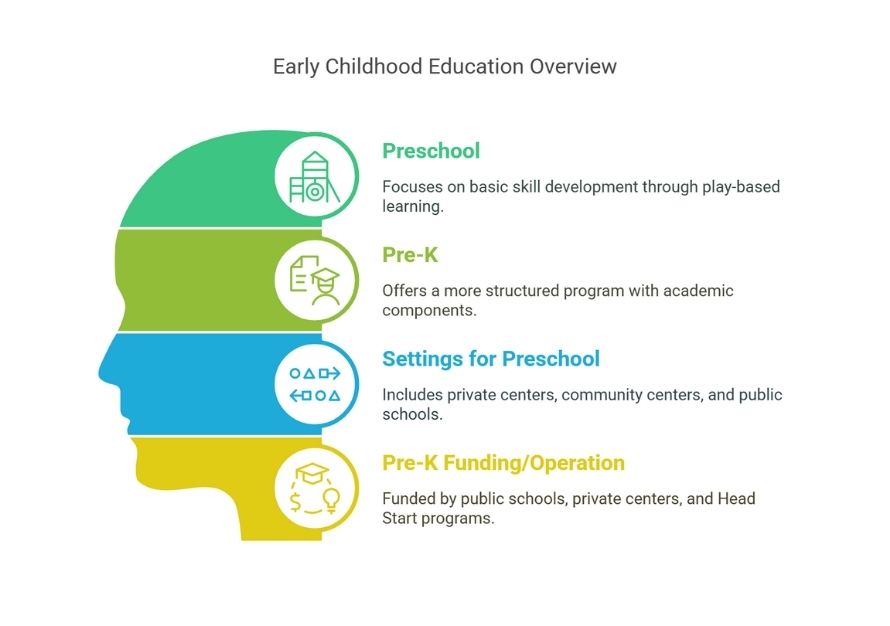
Preschool
Preschool is an early childhood education program designed for children who are not yet old enough to attend kindergarten. These programs are typically more play-based than academic, focusing on helping children develop basic social, emotional, physical, and cognitive skills. Preschool classrooms often blend structured activities—such as circle time, story sessions, and guided play—with free-choice or exploratory play that allows children to choose activities based on their interests.
Preschool can be located in a variety of settings, such as:
- Private childcare centers
- Community centers
- Churches or faith-based institutions
- Public schools (in some districts)
- Nonprofit organizations
The idea behind preschool is to give children an environment where they can socialize with peers, learn foundational concepts (like colors, shapes, and letters), and prepare for more structured educational experiences in elementary school.
Pre-K (Pre-Kindergarten)
Pre-K stands for pre-kindergarten. It is sometimes considered a slightly more advanced or structured program than preschool, often focusing on bridging the gap between informal early learning experiences and the more formal academic setting of kindergarten. Pre-K programs often emphasize early literacy, numeracy, and social skills, while still integrating significant amounts of play-based learning.
Pre-K can be funded or operated by:
- Public school systems (sometimes referred to as “universal Pre-K” if offered to all residents of a particular jurisdiction)
- Private childcare centers
- Head Start programs (a federally funded program in the U.S. aimed at low-income families)
- Community organizations in partnership with public schools
While both preschool and Pre-K foster critical early development, Pre-K may be slightly more structured with a stronger academic component, particularly in programs that are affiliated with public school districts.
Age Requirement for Pre-K and Preschool
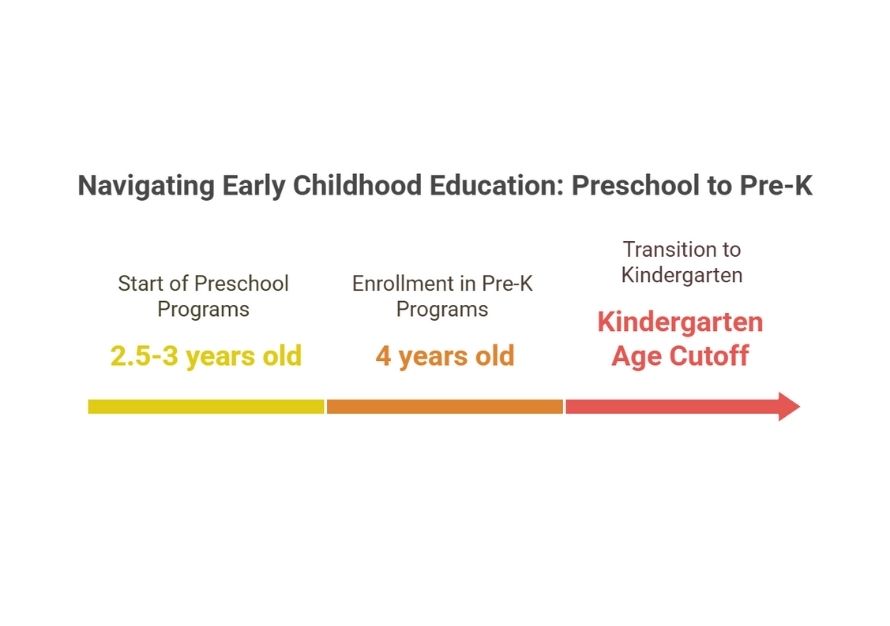
Preschool Age Range
Preschool programs typically start accepting children who are around two-and-a-half to three years old, and children can remain in preschool until they are old enough to enter kindergarten (which is generally around age five in most regions). That said, age requirements can vary by center or program. Some may allow children as young as two, provided they are potty trained, while others might start at age three.
Pre-K Age Range
In many places, Pre-K programs are designed for four-year-olds who will be entering kindergarten the following year. Some programs may accept children who are three turning four, while others are strictly for four-year-olds. The cutoff dates for enrollment often mirror the kindergarten age cutoff in your area. For example, if a child must be five years old by a specific month to start kindergarten, they must be four by that same month to enroll in Pre-K.
Overlap: There can be an overlap where a child who is four might still attend a preschool program if a structured Pre-K program isn’t available or if the family chooses a different educational route. Conversely, younger children might enter a Pre-K class if they turn four by a certain date. Thus, it’s always best to check the specific age requirements for each program in your area.
Curriculum and Focus of Pre-K and Preschool
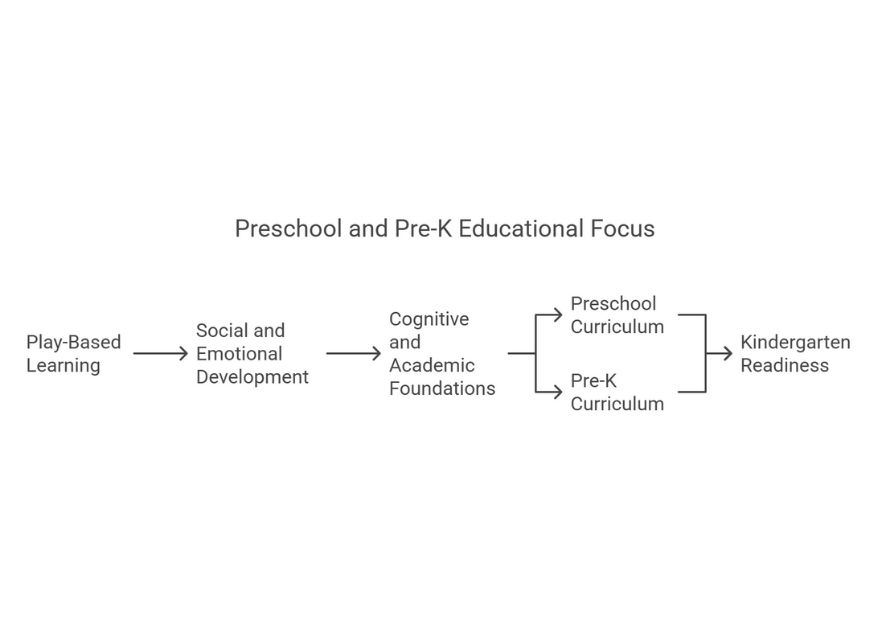
Emphasis on Play-Based Learning
Both preschool and Pre-K place a significant emphasis on play-based learning, which helps children understand the world by engaging in hands-on activities. This approach targets key developmental areas such as fine and gross motor skills, language acquisition, problem-solving, and social interaction.
Social and Emotional Development
One of the central goals in both preschool and Pre-K is to foster social and emotional growth. Children learn to:
- Share and take turns
- Express and manage their feelings
- Resolve conflicts with peers
- Develop empathy and respect for others
Teachers often guide children in learning how to articulate emotions effectively and build relationships. Group activities, circle time, and small classroom projects are common methods used to help children learn cooperation and teamwork.
Cognitive and Academic Foundations
- Preschool: Typically introduces basic concepts like colors, shapes, counting, and the alphabet. The curriculum remains quite flexible, with a focus on early literacy through storytime and interactive reading. Teachers also use music, art, and playful exercises to ignite a love for learning.
- Pre-K: Builds on these foundational skills, often focusing more on early literacy and numeracy. Children might begin to recognize sight words, write letters of the alphabet, and grasp simple math skills like counting beyond 20 and basic addition/subtraction concepts (through hands-on games). Some Pre-K programs incorporate structured lessons that more closely mirror a kindergarten classroom routine (e.g., calendar activities, weather discussions, guided reading sessions).
Readiness for Kindergarten
A crucial difference between preschool and Pre-K is the focus on school readiness:
- Preschool offers a broad, developmentally appropriate foundation.
- Pre-K aims to refine these skills so children can start kindergarten prepared to follow routines, engage with more academic material, and thrive in a classroom environment.
Benefits of Pre-K and Preschool

- Early Socialization
One of the most significant advantages of these programs is the early opportunity for children to interact with peers. They learn social norms, how to share and collaborate, and how to express themselves in group settings—skills that are beneficial throughout life. - Structured Routine
Both preschool and Pre-K introduce children to a structured day, complete with snack times, circle times, and activity rotations. This daily rhythm helps children feel secure and teaches them to adapt to routine transitions. - Boost in Confidence and Independence
As children master new skills—tying their shoes, identifying letters, or successfully participating in group activities—they develop confidence. The more confident a child is, the more willing they are to take on new challenges, both in and out of the classroom. - Academic Readiness
Children in preschool and Pre-K have repeated exposure to foundational concepts in language and math. This exposure, coupled with developmentally appropriate instruction, makes them better equipped to handle the increased academic demands of kindergarten and beyond. - Emotional Resilience
In early childhood programs, children learn to regulate their emotions, recover from disappointments, and adapt to new environments. Whether it’s navigating friendships or coping with minor conflicts, these experiences build resilience. - Diverse Experiences
Children in preschool and Pre-K encounter a wide range of activities—arts and crafts, storytelling, dramatic play, science experiments, and even some technology-based learning. This variety stimulates multiple areas of development and can spark interests that children might pursue later on.
Enrollment Options for Pre-K and Preschool
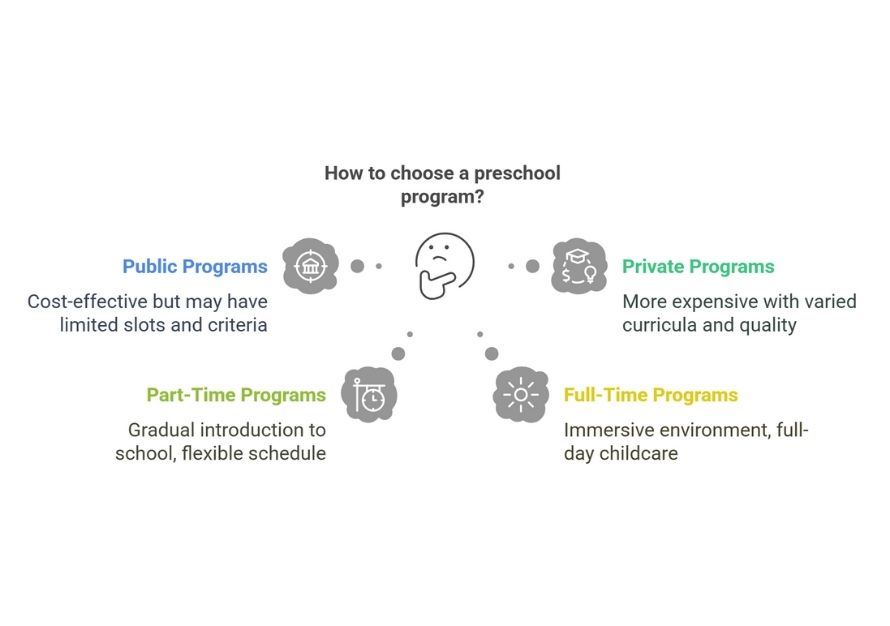
Public vs. Private
- Public Programs: In areas that offer public preschool or universal Pre-K, programs may be funded by the state or local government. This can substantially reduce costs for families. However, slots may be limited, and you might need to meet specific criteria (e.g., income level, geographic location).
- Private Programs: Typically more expensive than public options, private preschool and Pre-K can vary widely in cost, curriculum, and quality. Some may have specific educational philosophies (e.g., Montessori, Reggio Emilia, Waldorf) or religious affiliations.
Part-Time vs. Full-Time
- Part-Time: Many preschool programs offer part-day schedules—morning or afternoon sessions—or a few days a week (e.g., Monday-Wednesday-Friday). This can be a good fit for families who want to gradually introduce their child to a school-like setting.
- Full-Time: Some families need full-day programs for childcare reasons, or they prefer a more immersive educational environment. These programs typically run for a typical school day length, and sometimes include aftercare options.
Head Start and Community-Based Programs
In the United States, Head Start is a federally funded program aimed at helping children from low-income families receive early education, nutrition, and health services. Similar community-based programs exist in different countries and regions, offering subsidized or free preschool to qualifying families. Enrollment processes often involve eligibility criteria based on family income and local guidelines.
Specialized Programs
For children with special needs or developmental delays, there are specialized preschool and Pre-K programs with trained staff and adaptive curricula. These programs might include speech therapy, occupational therapy, or other supportive services within the classroom setting to ensure that each child receives personalized attention.
Parent Involvement in Pre-K and Preschool
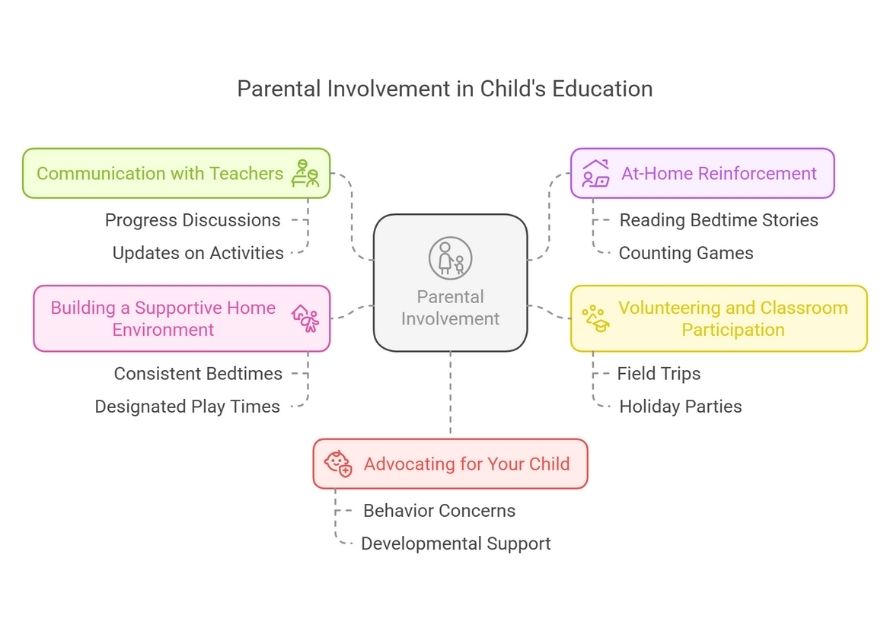
Communication with Teachers
Regular communication between parents and teachers is crucial. By discussing a child’s progress, parents can reinforce at home what’s being learned in the classroom. Many programs use newsletters, emails, or apps to keep parents updated on daily activities, upcoming events, or child-specific milestones.
At-Home Reinforcement
Learning doesn’t stop once the school day ends. Families who read bedtime stories, engage in counting games, or encourage children to practice writing their names help reinforce classroom learning. Simple conversations about the day—“What did you build at the block center today?”—can do wonders for verbal skills and self-reflection.
Volunteering and Classroom Participation
Some programs welcome (or even require) parent volunteers to assist with field trips, holiday parties, or special activities. Participating in the classroom environment allows parents to better understand the school’s culture, see their child’s social interactions, and connect with teachers and other parents.
Building a Supportive Home Environment
Establishing routines at home—consistent bedtimes, designated play and reading times—mirrors the structure children experience at school. A calm and predictable environment can reduce stress for children and help them transition more smoothly between home and school.
Advocating for Your Child
Parents know their children best. If there are concerns about a child’s behavior, development, or the classroom environment, open dialogue with teachers or administrators can lead to solutions. Whether it’s requesting extra support for language development or discussing strategies for managing separation anxiety, proactive engagement can make a tangible difference in a child’s educational experience.
Putting It All Together
Pre-K and preschool each serve as essential stepping stones in a child’s early development. While they share similarities—such as emphasizing social skills, play-based learning, and exploration—Pre-K often targets children closer to kindergarten age and may lean slightly more toward structured academic readiness.
By understanding the definitions, age requirements, and curriculum focus of these programs, families can make informed decisions based on their child’s developmental readiness and their family’s needs. The benefits of attending these early educational settings are vast, ranging from increased social competency to stronger academic foundations. Enrollment options are diverse, including public, private, and community-based programs, and many offer flexible scheduling and specialized services.
Finally, parent involvement cannot be understated. Whether through everyday conversations, volunteering, or simply being in close communication with teachers, engaged parents can amplify the impact of these early educational experiences. By working hand in hand with educators, parents ensure that their children build not only fundamental academic skills, but also the emotional and social resilience they need for a lifetime of learning.
With these foundational years firmly supported, children stand poised to transition into kindergarten with confidence, curiosity, and an eagerness to explore the world around them—key ingredients for future success in school and beyond.





